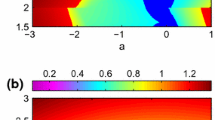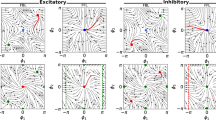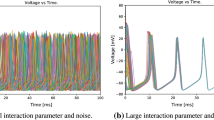Abstract
We consider various networks of diffusively coupled identical neurons modeled by a system of FitzHugh-Rinzel coupled differential equations. The mathematical model of a solitary nerve cell is analyzed theoretically and numerically. Regions corresponding to the qualitatively different behavior of a neuron are separated in the parameter space of the system. We present synchronization conditions in a network in which the central element modeling the pacemaking neuron is linked to the group of uncoupled neurons (star configuration). Within the framework of the connection graph stability method [1], which allows us to determine the character of variation in the threshold values of the coupling strengths sufficient for establishing the complete-synchronization regime, we study the influence of the network structure on the synchronization thresholds in different ensembles. In particular, we consider a configuration in the form of diffusively coupled stars structures.
Similar content being viewed by others
References
V. N. Belykh, I. V. Belykh, and M. Hasler, Physica D, 195, 159 (2004).
A. Pikovsky, M. Rosenblum, and J. Kurths, Synchronization: A Fundamental Concept in Nonlinear Sciences, Cambrdge Univ. Press, New York (2001).
S. Boccaletti, J. Kurths, G. Osipov, et al., Phys. Rep., 366, 1 (2002).
C. Sparrow, The Lorenz Equations, Bifurcations, Chaos, and Strange Attractors, Springer-Verlag, New York (1982).
O. E. Roessler, Phys. Lett. A, 57, 397 (1976).
P. R. Shorten and D. J. Wall, Bull. Math. Biol., 62, No. 4, 695 (2000).
I. Belykh, E. Lange, and M. Hasler, Phys. Rev. Lett., 94, 188101 (2005).
V. N. Belykh, I. V. Belykh, M. Colding-Jorgensen, and E. Mosekilde, Eur. Phys. J. E, 3, 205 (2000).
E. Izhikevich, Int. J. Bifurcation and Chaos., 10, 1171 (2000).
J. Rinzel, in: Lecture Notes in Biomath. Mathematical Topics in Population Biology, Morphogenesis, and Neurosciences, Vol. 71 Springer-Verlag, Berlin, 267 (1987).
E. Izhikevich, SIAM Review, 43, 315 (2001).
C. A. Del Negro, C.-F. Hsiao, S. H. Chandler and A. Garfinkel, Biophys. J., 75, 174 (1998).
F. Harary and E. M. Palmer, Graphical Enumeration, Academic Press, New York (1973).
N. N. Bautin, The Behavior of Dynamical Systems near the Boundaries of the Domain of Stability [in Russian], Nauka, Moscow (1984).
V. N. Belykh and Yu. S. Chertkov, in: Boundary-Value Problems. Collection of Papers [in Russian], Perm’ Polytech. Inst., Perm’ (1980), p. 120.
I. Belykh, M. Hasler, M. Lauret, and H. Nijmeijer, Int. J. Bifurcation and Chaos., 15, No. 11, 3423 (2005).
V. N. Belykh, I. V. Belykh, and M. Hasler, Physica D, 195, 188 (2004).
Author information
Authors and Affiliations
Additional information
__________
Translated from Izvestiya Vysshikh Uchebnykh Zavedenii, Radiofizika, Vol. 49, No. 11, pp. 1002–1014, November 2006.
Rights and permissions
About this article
Cite this article
Belykh, V.N., Pankratova, E.V. Chaotic synchronization in ensembles of coupled neurons modeled by the FitzHugh-Rinzel system. Radiophys Quantum Electron 49, 910–921 (2006). https://doi.org/10.1007/s11141-006-0124-z
Received:
Accepted:
Issue Date:
DOI: https://doi.org/10.1007/s11141-006-0124-z




